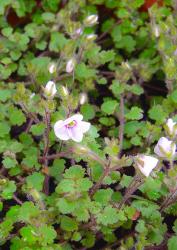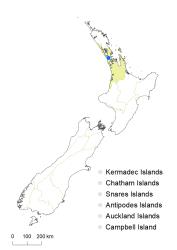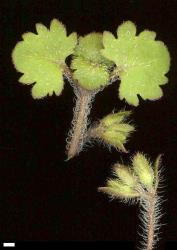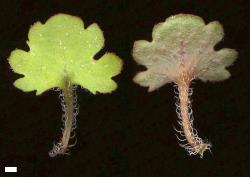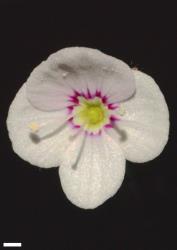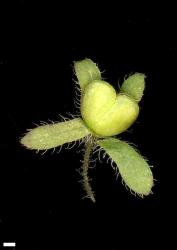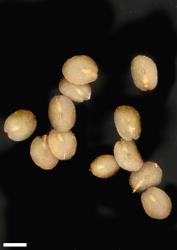- Taxon
- Gallery
- ≡ Parahebe jovellanoides (Garn.-Jones & de Lange) de Lange in de Lange et al., Threat. Pl. New Zealand 439 (2010)
Perennial herb to 0.05 m tall. Stems creeping to ascending at tips, eglandular-pubescent; hairs uniform. Leaf bud indistinct; leaves separating while very small, opposite-decussate but sub-distichous on prostrate stems, spreading; lamina thin, orbicular to deltoid or spathulate, 3.5–11.0 mm long, 4.5–12.0 mm wide, dull green above, pale green or pinkish beneath; veins several from base, weakly evident especially beneath; surfaces eglandular-hairy above and usually beneath, especially near veins; margin ciliate, deeply crenate or serrate; teeth in 3–5 pairs; apex obtuse to rounded; base truncate to sub-cordate; petiole 2–10 mm long. Inflorescence a lateral raceme, 40–80 mm long; flowers distant, 2–7, all bisexual; bracts alternate, linear to oblanceolate, < pedicels; pedicels spreading to ascending, 7–12 mm long, glandular- and eglandular-hairy all around. Calyx lobes 4, sub-acute to acute, 3.0–5.5 mm long, equal, glandular- and eglandular-hairy on margins and abaxially. Corolla 10–12 mm diameter; tube white and yellow, c. 1 mm long, < calyx, glabrous; lobes 4, white, spreading, unequal, elliptic to orbicular, 4.5–5.5 mm long, rounded; nectar guides magenta. Stamen filaments white, 4.0–4.5 mm long; anthers pink. Style glabrous, 3.5–4.0 mm long. Capsules angustiseptate, emarginate, glabrous, 3.2–6.0 mm long, 3.5–5.5 mm at widest point. Seeds ellipsoid, flattened, smooth, pale brown, 1.2–1.8 mm long.
Veronica jovellanoides is very distinctive, although it shares character states with several other species. V. jovellanoides flowers have short corolla tubes and prominent nectar guides like many in the speedwell hebe group, but they lack the plicate lateral lobes characteristic of V. lanceolata, V. hookeriana, and many South Island species. Plants of V. lilliputiana, also in the speedwell hebe group, are also creeping herbs, but they have tiny entire leaves and solitary blue flowers. V. linifolia plants have similar flowers to V. jovellanoides, but their narrow, glossy green, glabrous, entire leaves are diagnostic. The crenately lobed or bluntly serrate petiolate hairy leaves of V. jovellanoides are similar to those of V. spathulata, but that species has opposite flowers with a longer corolla tube and no nectar guides; its antrorse eglandular inflorescence hairs and hairy capsules also distinguish it.
The creeping herbaceous growth, coarsely toothed or crenate leaves, short-tubed corolla, and angustiseptate capsules are all features that make V. jovellanoides seem similar to a number of introduced species of Veronica, such as V. filiformis, V. persica, and V. hederifolia. Those species differ from V. jovellanoides in their blue flowers that are solitary in leaf axils.
Finally, V. plebeia and V. calycina plants share character states with V. jovellanoides, but differ most obviously in their blue flowers and only eglandular hairs on the inflorescences.
North Island: Auckland (known only from three wild plants at Ernest Morgan Reserve, Ararimu Valley Road, near Waimauku).
The only known habitat is floor of riparian Kunzea forest (Davidson et al. 2009). The recorded elevation is 35 m.
Flowers: October–December; fruits: December–February.
2n = 40 (B.G. Murray in Davidson et al. 2009; Murray & de Lange 2013).
Veronica jovellanoides is classified in V. subg. Pseudoveronica sect. Hebe (Albach & Meudt 2010). Molecular phylogenetic research places V. jovellanoides in an unresolved position at the base of the speedwell hebe clade. This is consistent with its morphology.



